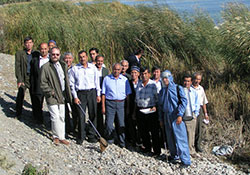Country work

WHO
The path towards malaria elimination
Over the past 20 years, intensive anti-malaria interventions have substantially reduced the number of reported autochthonous malaria cases in the WHO European Region from 90 712 cases in 1995 to zero in 2015.
Since 2005, all malaria-affected countries of the Region have moved towards elimination and revised their national strategies on malaria.
The last indigenous case of P. falciparum malaria in the Region was reported in Tajikistan in 2009. Tajikistan was the only country in the Region where P. falciparum malaria – responsible for most malaria-related deaths globally – had re-emerged. By 2010, 179 cases of malaria were reported in 6 countries. The years 2011 and 2012 saw renewed malaria transmission in Georgia (isolated cases) and in Greece and Turkey (localized outbreaks), as a result of malaria importation from other endemic countries (Afghanistan, India and Pakistan).
These resurgences were brought under control, and in 2014, indigenous transmission was confined to Tajikistan. For the first time in 2015, all countries in the Region reported zero indigenous cases of malaria.
Staying at zero
The achievement of zero indigenous malaria cases in the WHO European Region is extraordinary but fragile. Although zero cases were reported in 2015, the Region is subject to continual importation of cases from other endemic areas, which brings the threat of re-establishment of transmission.
Maintaining zero cases in the Region will require sustained political commitment and constant vigilance. Any new cases of the disease must be promptly identified and treated. Health systems should be strengthened to ensure that any resurgence is rapidly contained.
The "Regional framework for prevention of malaria reintroduction and certification of malaria elimination 2014–2020" outlines:
- ways to avoid the resurgence of malaria
- objectives to eliminate malaria and prevent its reintroduction
- aspects of the malaria-free certification process.



